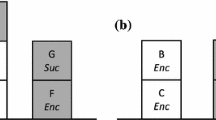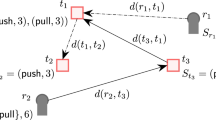Abstract
A problem that has recently attracted the attention of the research community is the autonomous formation of robot teams to perform complex multi-robot tasks. The corresponding problem for software agents is also known in the multi-agent community as the coalition formation problem. Numerous algorithms for software agent coalition formation have been provided that allow for efficient cooperation in both competitive and cooperative environments. However, despite the plethora of relevant literature on the software agent coalition formation problem, and the existence of similar problems in theoretical computer science, the multi-robot coalition formation problem has not been sufficiently grounded for different tasks and task environments. In this paper, comparisons are drawn to highlight the differences between software agents and robotics, and parallel problems from theoretical computer science are identified. This paper further explores robot coalition formation in different practical robotic environments. A heuristic-based coalition formation algorithm from our previous work was extended to operate in precedence ordered cooperative environments. In order to explore coalition formation in competitive environments, the paper also studies the RACHNA system, a market based coalition formation system. Finally, the paper investigates the notion of task preemption for complex multi-robot tasks in random allocation environments.
Similar content being viewed by others
Explore related subjects
Discover the latest articles, news and stories from top researchers in related subjects.References
Abdallah, S., Lesser, V.: Organization-based cooperative coalition formation. In: Proceedings of the IEEE/WIC/ACM International Conference on Intelligent Agent Techonology, IAT, pp. 162–168 (2004)
Balas, E., Padberg, M.: Set partitioning: a survey. SIAM Rev. 18, 710–760 (1976)
Balch, T., Arkin, R.C.: Communication in reactive multiagent robotic systems. Auton. Robots 1(1), 1–25 (1994)
Bar-Yehuda, R., Even, S.: A linear time approximation algorithm for the weighted vertex cover problem. J. Algorithms 2, 198–203 (1981)
Blum, A.L., Furst, M.L.: Fast planning through planning graph analysis. Artif. Intell. 90, 281–300 (1997)
Borgwardt, K.-H.: Some distribution-independent results about the asymptotic order of the average number of pivot steps of the simplex algorithm. Math. Oper. Res. 7, 441–461 (1982)
Botelho, S.C., Alami, R.: M+: a scheme for multi-robot cooperation through negotiated task allocation and achievement. In: Proceedings of IEEE International Conference on Robotics and Automation, pp. 1234–1238 (1999)
Brooks, R.A.: A robust layered control system for a mobile robot. IEEE J. Robot. Autom. 2(1), 14–23 (1986)
Caloud, P., Choi, W., Latombe, J.-C., Pape, C.L., Yim, M.: Indoor automation with many mobile robots. In: Proceedings of the IEEE/RSJ International Conference on Intelligent Robots and Systems, pp. 67–72 (1990)
Chu, P.C., Beasley, J.E.: A genetic algorithm for the set covering problem. Eur. J. Oper. Res. 94, 396–404 (1996)
Chvatal, V.: A greedy heuristic for the set-covering problem. Math. Oper. Res. 4(3), 233–235 (1979)
Collins, J., Jamison, S., Mobasher, B., Gini, M.: A market architecture for multi-agent contracting. Technical Report 97-15, University of Minnesota, Department of Computer Science (1997)
Dahl, T.S., Matarić, M.J., Sukhatme, G.S.: Multi-robot task-allocation through vacancy chains. In: Proceedings of IEEE International Conference on Robotics and Automation, pp. 14–19 (2003)
Dantzig, G.B.: Linear Programming and Extensions. Princeton University Press, Princeton, NJ (1972)
DeVries, S.,Vohra, R.: Cominatorial auctions: a survey. INFORMS J. Comput. 135, 284–309 (2003)
Dias, M.B.: TraderBots: a new paradigm for robust and efficient multirobot coordination in dynamic environments. Ph.D. thesis, The Robotics Institute, Carnegie Mellon University (2004)
Dijkstra, E.W.: The mathematics behind the banker’s algorithm. In: Dijkstra, E.W. (ed.) Selected Writings on Computing: A Personal Perspective, pp. 308–312 (1977)
Dyer, M.E., Wolsey, L.A.: Formulating the single machine sequencing problem with release dates as a mixed integer programming problem. Discrete Appl. Math. 26, 255–270 (1990)
Fass, L.F.: Automatic-theoretic view of agent coalitions. Technical Report WS-04-06, American Association of Artificial Intelligence Workshop on Forming and Maintaining Coalitions and Teams in Adaptive Multiagent Systems (2004)
Fisher, M., Kedia, P.: Optimal solution of set covering/partitioning problems using dual heuristics. Manage. Sci. 36(6), 674–688 (1990)
Garrido, A., Salido, M., Barber, F., López, M.: Heuristic methods for solving job-shop scheduling problems. In: PuK (2000)
Gasser, L.: Social knowledge and social action. In: International Joint Conference on Artificial Intelligence, pp. 751–757 (1993)
Gerkey, B., Matarić, M.J.: A framework for studying multi-robot task allocation. In: Proceedings of the Multi-robot Systems: From Swarms to Intelligent Automata, vol. 2, pp. 15–26 (2003)
Gerkey, B., Matarić, M.J.: Are (explicit) multi-robot coordination and multi-agent coordination really so different? In: Proceedings of the AAAI Spring Symposium on Bridging the Multi-agent and Multi-robotic Research Gap, pp. 1–3 (2004)
Gerkey, B.P., Matarić, M.J.: MURDOCH: Publish/subscribe task allocation for heterogeneous agents. In: Proceedings of Autonomous Agents, pp. 203–204 (2000)
Gerkey, B.P., Matarić, M.J.: Pusher–watcher: an approach to fault-tolerant tightly-coupled robot coordination. In: Proceedings of the IEEE International Conference on Robotics and Automation, pp. 464–469 (2002a)
Gerkey, B.P., Matarić, M.J.: Sold!: auction methods for multi-robot coordination. IEEE Trans. Robot. Autom. (Special issue on multi-robot systems) 18(5), 758–768 (2002b)
Gerkey, B.P., Vaughan, R.T., Stoy, K., Howard, A., Sukhatme, G.S., Matarić, M.J.: Most valuable player: a robot device server for distributed control. In: Proceedings of the IEEE/RSJ International Conference on Intelligent Robots and Systems, pp. 1226–1231 (2001)
Klee, V., Minty, G.: How good is the simplex algorithm? In: Shisha, O. (ed.) Qualities, vol. III, pp. 159–175 (1972)
Korte, B., Vygen, J.: Combinatorial Optimization: Theory and Optimization. Springer, Berlin (2000)
Laengle, T., Lueth, T.C., Rembold, U., Woern, H.: A distributed control architecture for autonomous mobile robots. Adv. Robot. 12(4), 411–431 (1998)
Lang, S.: An extended banker’s algorithm for deadlock avoidance. IEEE Trans. Softw. Eng. 3, 428–432 (1999)
Leyton-Brown, K., Shoham, Y., Tennenholtz, M.: An algorithm for multi-unit combinatorial auctions. In: Proceedings of the 17th National Conference on Artificial Intelligence, pp. 56–61 (2000)
Li, X., Soh, L.-K.: Investigating reinforcement learning in multiagent coalition formation. Technical report no. WS-04-06, American Association of Artificial Intelligence Workshop on Forming and Maintaining Coalitions and Teams in Adaptive Multiagent Systems, pp. 22–28 (2004)
Lin, L., Zheng, Z.: Combinatorial bids based multi-robot task allocation. In: Proceedings of the International Conference on Robotics and Automation, pp. 1145–1150 (2005)
Low, K.H., Leow, W.K., Ang Jr., M.H.: Task allocation via self-organizing swarm coalitions in distributed mobile sensor network. In: Proceedings of the American Association of Artificial Intelligence, pp. 28–33 (2004)
Parker, L.E.: The effect of action recognition and robot awareness in cooperative robotic teams. In: Proceedings of the IEEE/RSJ International Conference on Intelligent Robots and Systems, vol. 1, pp. 212–219 (1995)
Parker, L.E.: ALLIANCE: an architecture for fault tolerant multi-robot cooperation. IEEE Trans. Robot. Autom. 14(2), 220–240 (1998)
Sadeh, N.M., Fox, M.S.: Variable and value ordering heuristics for the job shop scheduling constraint satisfaction problem. Artif. Intell. 86, 1–41 (1996)
Sadeh, N.M., Sycara, K., Xiong, Y.: Backtracking techniques for the job shop scheduling constraint satisfaction problem. Artif. Intell. 76, 455–480 (1995)
Sandholm, T.: An implementation of the contract net protocol based on marginal cost calculations. In: Proceedings of the Eleventh National Conference on Artificial Intelligence, pp. 256–262 (1993)
Sandholm, T.: Algorithm for optimal winner determination in cominatorial auctions. Artif. Intell. 135, 1–54 (2002)
Sandholm, T., Lesser, V.: Advantages of a leveled commitment contracting protocol. In: Proceedings of the Thirteenth National Conference on Artificial Intelligence, pp. 126–133 (1996)
Sandholm, T.W., Larson, K., Andersson, M., Shehory, O., Tomhe, F.: Coalition structure generation with worst case guarantees. Artif. Intell. 111(1,2), 209–238 (1999)
Sandholm, T.W., Lesser, V.R.: Coalition formation among bounded rational agents. In: Proceedings of International Joint Conference on Artificial Intelligence, pp. 662–669 (1995)
Schneider, J., Apfelbaum, D., Bagnell, D., Simmons, R.: Learning opportunity costs in multi-robot market based planners. In: Proceedings of the International Conference on Robotics and Automation, pp. 1151–1156 (2005)
Schrijver, A.: Theory of Linear and Integer Programming. Wiley, Amsterdam (1986)
Shehory, O., Kraus, S.: Task allocation via coalition formation among autonomous agents. In: Proceedings of International Joint Conference on Artificial Intelligence, pp. 655–661 (1995)
Shehory, O., Kraus, S.: Formation of overlapping coalitions for precedence ordered task-execution among autonomous agents. In: Proceedings of International Conference on Multi Agent Systems, pp. 330–337 (1996)
Shehory, O., Kraus, S.: Methods for task allocation via agent coalition formation. Artif. Intell. 101(1,2), 165–200 (1998)
Smith, R.G.: The contract net protocol: high level communication and control in a distributed problem solver. IEEE Trans. Comput. 29(12), 1104–1113 (1980)
Sorbella, R., Chella, A., Arkin, R.: Metaphor of politics: a mechanism of coalition formation. Technical Report WS-04-06, American Association of Artificial Intelligence Workshop on Forming and Maintaining Coalitions and Teams in Adaptive Multiagent Systems (2004)
Spielman, D.A., Teng, S.-H.: Smoothed analysis: why the simplex algorithm usually takes polynomial time. In: Proceedings of ACM Symposium on Theory of Computing, pp. 296–305 (2001)
Srinivasan, V.: A hybrid algorithm for the one machine sequencing problem to minimize total tardiness. Nav. Res. Logist. Q. 18, 317–327 (1971)
Stearns, R.E.: Convergent transfer schemes for n-person games. Trans. Am. Math. Soc. 134, 449–459 (1968)
Stentz, A., Dias, M.B.: A free market architecture for coordinating multiple robots. Technical Report CMU-RI-TR-01-26, The Robotics Institute, Carnegie Mellon University (1999)
Sycara, K., Zeng, D.: Coordination of multiple intelligent software agents. Int. J. Intell. Coop. Inf. Syst. 5(2-3), 181–211 (1996)
Tang, F., Parker, L.E.: Coalescing multi-robot teams through ASyMTRe: a formal analysis. In: Proceedings of the IEEE International Conference on Advanced Robotics, pp. 817–824 (2005)
Vig, L., Adams, J.A.: Issues in multi-robot coalition formation. In: Parker, L.E., Schneider, F.E., Schultz, A.C. (eds.) Proceedings of Multi-Robot Systems. From Swarms to Intelligent Automata, Washington, DC, vol. 3, pp. 15–26. Springer, Berlin (2005)
Vig, L., Adams, J.A.: Market-based multi-robot coalition formation. In: Gini, M., Voyles, R. (eds.) Distributed Autonomous Robotics Systems, Minneapolis, vol. 7, pp. 227–236. Springer, Berlin (2006a)
Vig, L., Adams, J.A.: Multi-robot coalition formation. IEEE T. Robot. 22(4), 637–649 (2006b)
Wagner, H.M.: An integer programming model for machine scheduling. Nav. Res. Loqist. Q. 6, 131–140 (1959)
Werger, B., Matarić, M.J.: Broadcast of local eligibility: behavior based control for strongly cooperative multi-robot teams. In: Proceedings of Autonomous Agents, pp. 21–22 (2000)
Wu, L.S.: A dynamic theory for the class of games with nonempty cores. SIAM J. Appl. Math. 32, 328–338 (1977)
Zlot, R., Stentz, A.: Complex task allocation for multiple robots. In: Proceedings of the IEEE Conference on Robotics and Automation, pp. 67–72 (2005)
Author information
Authors and Affiliations
Corresponding author
Additional information
Manuscript submitted on the 1st of September 2006, Lovekesh Vig is a graduate student in the EECS Department at Vanderbilt University, Nashville TN 37212. Julie A. Adams is a Assistant Professor in the EECS Department at Vanderbilt University, Nashville TN 37212.
Rights and permissions
About this article
Cite this article
Vig, L., Adams, J.A. Coalition Formation: From Software Agents to Robots. J Intell Robot Syst 50, 85–118 (2007). https://doi.org/10.1007/s10846-007-9150-0
Received:
Accepted:
Published:
Issue Date:
DOI: https://doi.org/10.1007/s10846-007-9150-0




